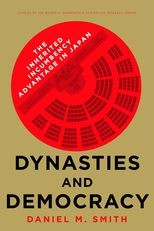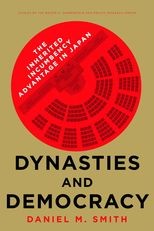Dynasties and Democracy: The Inherited Incumbency Advantage in Japan
Dynasties and Democracy: The Inherited Incumbency Advantage in Japan
Cite
Abstract
Democracy is supposed to be the antithesis of hereditary rule by family dynasties. And yet “democratic dynasties” continue to persist in democracies around the world. They have been conspicuously prevalent in Japan, where more than a third of all legislators and two-thirds of all cabinet ministers in recent years have come from families with a history in parliament. Such a high proportion of dynasties is unusual and has sparked concerns over whether democracy in Japan is functioning properly. This book introduces a comparative theory to explain the causes and consequences of dynasties in democracies like Japan. Members of dynasties enjoy an “inherited incumbency advantage” in all three stages of a typical political career: selection, election, and promotion. However, the nature and extent of this advantage, as well as its consequences for elections and representation, varies by the institutional context of electoral rules and candidate selection methods within parties. In the late 1980s, roughly half of all new candidates in Japan’s long-ruling Liberal Democratic Party were political legacies. However, electoral system reform in 1994 and subsequent party reforms have changed the incentives for party leaders to rely on dynastic politics in candidate selection. A new pattern of party-based competition is slowly replacing the old pattern of competition based on localized family fiefdoms.
-
Front Matter
-
One
Introduction: Dynasties in Democracies
-
Two
Putting Japan into Comparative Perspective
-
Three
A Comparative Theory of Dynastic Candidate Selection
-
Four
Selection: From Family Business to Party Priority
-
Five
Election: The Inherited Incumbency Advantage
-
Six
Promotion: Dynastic Dominance in the Cabinet
-
Seven
The Consequences of Dynastic Politics for Representation
-
Eight
Conclusion: Family Fiefdoms and Party Politics
-
End Matter
Sign in
Personal account
- Sign in with email/username & password
- Get email alerts
- Save searches
- Purchase content
- Activate your purchase/trial code
Institutional access
-
Sign in through your institution
- Sign in with a library card Sign in with username/password Recommend to your librarian
Institutional account management
Sign in as administratorPurchase
Our books are available by subscription or purchase to libraries and institutions.
Purchasing information| Month: | Total Views: |
|---|---|
| October 2022 | 4 |
| October 2022 | 4 |
| October 2022 | 4 |
| October 2022 | 5 |
| October 2022 | 20 |
| October 2022 | 4 |
| October 2022 | 5 |
| October 2022 | 4 |
| October 2022 | 4 |
| October 2022 | 4 |
| October 2022 | 4 |
| October 2022 | 2 |
| October 2022 | 8 |
| October 2022 | 4 |
| October 2022 | 11 |
| October 2022 | 8 |
| October 2022 | 4 |
| October 2022 | 2 |
| November 2022 | 1 |
| December 2022 | 1 |
| January 2023 | 1 |
| January 2023 | 1 |
| January 2023 | 2 |
| March 2023 | 2 |
| March 2023 | 2 |
| April 2023 | 1 |
| June 2023 | 2 |
| June 2023 | 3 |
| June 2023 | 1 |
| June 2023 | 1 |
| January 2024 | 2 |
| January 2024 | 5 |
| January 2024 | 2 |
| January 2024 | 1 |
| January 2024 | 3 |




Get help with access
Institutional access
Access to content on Oxford Academic is often provided through institutional subscriptions and purchases. If you are a member of an institution with an active account, you may be able to access content in one of the following ways:
IP based access
Typically, access is provided across an institutional network to a range of IP addresses. This authentication occurs automatically, and it is not possible to sign out of an IP authenticated account.
Sign in through your institution
Choose this option to get remote access when outside your institution. Shibboleth/Open Athens technology is used to provide single sign-on between your institution’s website and Oxford Academic.
If your institution is not listed or you cannot sign in to your institution’s website, please contact your librarian or administrator.
Sign in with a library card
Enter your library card number to sign in. If you cannot sign in, please contact your librarian.
Society Members
Society member access to a journal is achieved in one of the following ways:
Sign in through society site
Many societies offer single sign-on between the society website and Oxford Academic. If you see ‘Sign in through society site’ in the sign in pane within a journal:
If you do not have a society account or have forgotten your username or password, please contact your society.
Sign in using a personal account
Some societies use Oxford Academic personal accounts to provide access to their members. See below.
Personal account
A personal account can be used to get email alerts, save searches, purchase content, and activate subscriptions.
Some societies use Oxford Academic personal accounts to provide access to their members.
Viewing your signed in accounts
Click the account icon in the top right to:
Signed in but can't access content
Oxford Academic is home to a wide variety of products. The institutional subscription may not cover the content that you are trying to access. If you believe you should have access to that content, please contact your librarian.
Institutional account management
For librarians and administrators, your personal account also provides access to institutional account management. Here you will find options to view and activate subscriptions, manage institutional settings and access options, access usage statistics, and more.